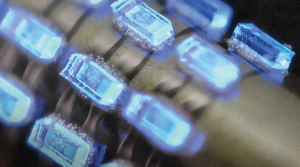Next-generation optoelectronic devices, such as quantum dots and perovskite light-emitting diodes, could potentially be used to build stretchable, multifunctional displays.
Last October, the discovery and synthesis of quantum dots earned three researchers — Mungi Bawendi of Massachusetts Institute of Technology, Louis Bruss of Columbia University, and Alexei Yekimov of New York-based Nanocrystal Technology Inc. — the Nobel Prize in Chemistry. These nanoscale semiconductor crystals have optoelectronic properties governed by quantum mechanical effects. As a result, nanocrystals can be tuned to emit specific wavelengths of light by controlling the particle size.

A photo of a 4 × 4 blue microLED array wrapped around a cylindrical rod, fabricated using a site-selective integration strategy developed by Hong and colleagues.
Credit: Yoon Hyun-soo, Jeong Su-jin, Seoul National University
The materials can be used in a wide range of applications, from medical imaging to solar cells, and are already the basis of a growing global market worth billions of dollars a year, but perhaps their most prominent use so far is in displays: televisions containing quantum dots have been commercially available since 2013.
In these commercial displays, quantum dots exploit their photoluminescent properties to act as color conversion films. But devices can also be built using the material’s electroluminescent properties, where light emission is achieved by electric current in a light-emitting diode (LED) configuration. Such systems could provide an even more powerful technology, from large panel displays to virtual reality headset screens. The potential for this application is covered in this issue. Nature ElectronicsDae-Hyeong Kim and colleagues report the development of inherently stretchable quantum dot LEDs.
Researchers based at different laboratories in South Korea created a device from a mechanically soft and stretchable light-emitting layer containing a ternary nanocomposite of colloidal quantum dots, an elastomeric polymer, and a charge-transporting polymer. The resulting device achieved a high brightness of 15,170 cd m.−2 It remains stable under 50% strain at 6.2 V. Kim and colleagues have created a full-color passive matrix array of intrinsically stretchable quantum dot LEDs that remains stable under a range of mechanical deformations.
Of course, quantum dot LEDs are competing with a variety of other next-generation display technologies, one of which is microLED.1In another article in this issue, Yongtaek Hong et al. report a site-selective integration strategy for microdevices on conformable substrates that they use to assemble microLED arrays on a variety of flexible substrates that can be bent and stretched.
The researchers, based at Seoul National University and Stanford University, use a dip-transfer coating technique to selectively pattern an adhesive precursor onto the surface of microdevices. The adhesive contains ferromagnetic particles that can self-assemble into anisotropic chains using a magnetic field. This results in low contact resistance for interconnecting devices and eliminates electrical interference between fine-pitch terminals. As well as assembling flexible and stretchable microLED arrays, the research team has shown that this strategy can also be used to create a skin-attachable device that can detect temperature and visualize it on a microLED display.
Typically, the only function of a display is to show visual information, and additional sensors are integrated into the device to provide other functions such as touch control or ambient light sensing. However, the use of photoresponsive LEDs that can both show information and respond to light excitation makes it possible to create displays that are inherently multifunctional. In another article in this issue, Feng Gao and colleagues report on the development of a display based on photoresponsive metal halide perovskite LEDs, using another category of novel LED technology.
Photoresponsive LEDs have previously been made using quantum dots (integrated into double-heterojunction nanorod structures).2However, their weak photoresponse limits their widespread application. Researchers based at Linköping University, Nanjing University, Nanjing Institute of Technology, Changzhou University, Westlake University and the University of Oxford turned their attention to perovskite LEDs, whose performance has improved rapidly in recent years and can now provide bright light emission and high photoresponse.
The team used perovskite LEDs to create a multifunction display that acts as a touchscreen, ambient light sensor, and image sensor. They also show that the display can act as a photovoltaic device to charge devices. However, as Stanford University’s Sebastian Fernández, Manchen Hu, and Daniel Congreve explain in an accompanying News & Views article, several issues remain to be resolved before the technology can be considered commercially viable. In particular, while Gao et al. have created a monochromatic multifunction display, integrating sensing capabilities into a full-color red-green-blue display would be an important next step.

